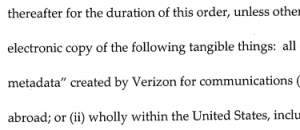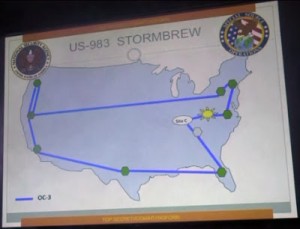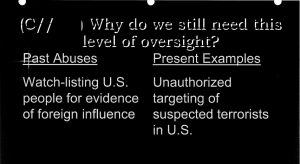Obama’s speech as written is below, with my comments (no indent) included.
At the dawn of our Republic, a small, secret surveillance committee borne out of the “The Sons of Liberty” was established in Boston. The group’s members included Paul Revere, and at night they would patrol the streets, reporting back any signs that the British were preparing raids against America’s early Patriots.
As I noted, raising Paul Revere is a really problematic analogy, because had the Brits done metadata analysis on Revere the way the government does on people who might also be called dissidents, we would still be eating kidney pie and hailing Queen Elizabeth.
Throughout American history, intelligence has helped secure our country and our freedoms. In the Civil War, Union balloon reconnaissance tracked the size of Confederate armies by counting the number of camp fires. In World War II, code-breaking gave us insight into Japanese war plans, and when Patton marched across Europe, intercepted communications helped save the lives of his troops. After the war, the rise of the Iron Curtain and nuclear weapons only increased the need for sustained intelligence-gathering. And so, in the early days of the Cold War, President Truman created the National Security Agency to give us insight into the Soviet bloc, and provide our leaders with information they needed to confront aggression and avert catastrophe.
Note that Obama presumes a war footing, even while 2 of the 3 primary foreign intelligence objectives he discussed (and others, as I’ll note) have nothing to do with war.
Note that this history lesson does not explain what higher purpose the wars — and therefore the intelligence — served. That’s important, because at the end of his speech he says it served to defend the Constitution, when in fact it was defending what we now call “the Homeland.”
Throughout this evolution, we benefited from both our Constitution and traditions of limited government. U.S. intelligence agencies were anchored in our system of checks and balances – with oversight from elected leaders, and protections for ordinary citizens.
So here the Constitution becomes not what we defend, but a limit we use when fighting wars.
Meanwhile, totalitarian states like East Germany offered a cautionary tale of what could happen when vast, unchecked surveillance turned citizens into informers, and persecuted people for what they said in the privacy of their own homes.
A nod to Angela Merkel. Also, I’d be curious how many Muslims the Obama Administration has not just persecuted, but prosecuted, for what they said in the privacy of their own homes?
In fact even the United States proved not to be immune to the abuse of surveillance. In the 1960s, government spied on civil rights leaders and critics of the Vietnam War. Partly in response to these revelations, additional laws were established in the 1970s to ensure that our intelligence capabilities could not be misused against our citizens. In the long, twilight struggle against Communism, we had been reminded that the very liberties that we sought to preserve could not be sacrificed at the altar of national security.
As I note relentlessly, according to the NSA itself, it had 3 different “present examples” of such abuses in 2009. This is not the distant past. It’s just the as-yet undisclosed immediate past.
If the fall of the Soviet Union left America without a competing superpower, emerging threats from terrorist groups, and the proliferation of weapons of mass destruction placed new – and, in some ways more complicated – demands on our intelligence agencies.
Note that throughout this passage, Obama only mentions 2 of the 3 main targets we use Section 702 for: terrorism and counterproliferation, making not mention of cybersecurity. That allows him to rationalize what he gets very close to admitting is domestic spying using the prior example of terrorism, even while cybersecurity was already an issue in 2011.
Globalization and the Internet made these threats more acute, as technology erased borders and empowered individuals to project great violence, as well as great good. Moreover, these new threats raised new legal and policy questions. For while few doubted the legitimacy of spying on hostile states, our framework of laws was not fully adapted to prevent terrorist attacks by individuals acting on their own, or acting in small, ideologically driven groups rather than on behalf of a foreign power.
The horror of September 11th brought these issues to the fore. Across the political spectrum, Americans recognized that we had to adapt to a world in which a bomb could be built in a basement, and our electric grid could be shut down by operators an ocean away.
See how quickly he inserts cybersecurity into the terrorism framework?
We were shaken by the signs we had missed leading up to the attacks – how the hijackers had made phone calls to known extremists, and travelled to suspicious places.
No mention of the information sharing of data collected that didn’t occur.
So we demanded that our intelligence community improve its capabilities, and that law enforcement change practices to focus more on preventing attacks before they happen than prosecuting terrorists after an attack.
It is hard to overstate the transformation America’s intelligence community had to go through after 9/11. Our agencies suddenly needed to do far more than the traditional mission of monitoring hostile powers and gathering information for policymakers – instead, they were asked to identify and target plotters in some of the most remote parts of the world, and to anticipate the actions of networks that, by their very nature, cannot be easily penetrated with spies or informants.
And it is a testimony to the hard work and dedication of the men and women in our intelligence community that over the past decade, we made enormous strides in fulfilling this mission. Today, new capabilities allow intelligence agencies to track who a terrorist is in contact with, and follow the trail of his travel or funding.
And again, Obama focuses on terrorism, when precisely the same tactics (and then some) are used against cybertargets.
New laws allow information to be collected and shared more quickly between federal agencies, and state and local law enforcement.
Does Obama’s mention of “state and local law enforcement agencies” in conjunction with nods to the PATRIOT Act make you more comfortable about all this data sharing of bulk data?
Read more →




